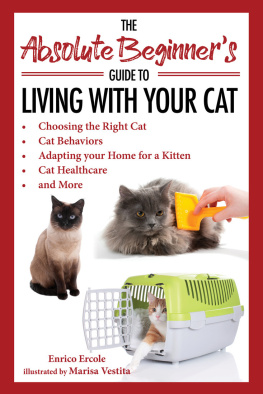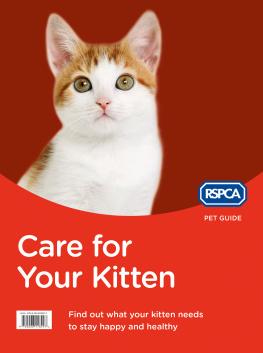

Copyright 2016 by Enrico Ercole
First Racehorse Publishing edition, 2020
Originally published in 2016 in English as Living in Harmony with Your Cat by White Star SRL
All rights reserved. No part of this book may be reproduced in any manner without the express written consent of the publisher, except in the case of brief excerpts in critical reviews or articles. All inquiries should be addressed to Racehorse Publishing, 307 West 36th Street, 11th Floor, New York, NY 10018.
Racehorse Publishing books may be purchased in bulk at special discounts for sales promotion, corporate gifts, fund-raising, or educational purposes. Special editions can also be created to specifications. For details, contact the Special Sales Department, Skyhorse Publishing, 307 West 36th Street, 11th Floor, New York, NY 10018 or .
Racehorse Publishing is a pending trademark of Skyhorse Publishing, Inc., a Delaware corporation.
Visit our website at www.skyhorsepublishing.com.
10 9 8 7 6 5 4 3 2 1
Library of Congress Cataloging-in-Publication Data is available on file.
Translation by TperTradurre
Cover design by Kai Texel
Cover image credit: Getty Images
Print ISBN: 978-1-63158-594-4
E-Book ISBN: 978-1-63158-595-1
Printed in China

Contents
.
.
.
.
.
.
.
.
.

Choosing the Right Cat

Deciding to live with a cat is an important step that should never be taken lightly. Too often we hear that this animal is less of a commitment because it doesnt get attached to the owner but to the house or because it poops and pees in the litter box and does not need to be taken for a walk. Nothing is farther from the truth. The cat is an animal that needs a deep and symbiotic relationship with the environment that surrounds it, especially with the human members of its family group. Just because they dont come to greet you when you come home (a behavior that is actually characteristic of many felines) does not mean that they dont need your company. Living with a cat means learning to understand the language and mechanisms that rule its social interactions. This means learning to reason like a cat, because your little friend will interact with you exactly as it would with another animal of its species. This is not easy, but it must be done. If you learn to understand it, your life with a feline will bring you a lot of joy. The first question an aspiring owner (with a cat the quotation marks are always a must) must ask him/herself is Do I have enough time to dedicate to the pet? Although its true that a cat does not need to be taken for walks, it still needs at least two hours of your company a day. It needs to play with you and receive a good dose of petting. Then there is bedtime, which it will want to spend with you at all costs. Its not a prescription: the two hours can be distributed as you prefer but they must be as regular as possible because the cat is a very, very habitual animal. Hence, you can leave it alone in the house the whole day (as cats rest for an average of eight hours every twelve) but you should never ignore its requests for attention when you get back. This is even truer for purebred, long or semi-long haired cats, who also need a brushing and occasional cleaning of the eyes and ears.


Debunking a myth: the cat does not get attached only to the home. It develops habits linked to the domestic environment but also becomes strongly attached to people.
The second point to take into careful consideration is how willing you are to share a house with an animal that is not as trainable as a dog. In short, those getting ready to take in a cat should not expect a decisive No! to be sufficient to prevent the animal from jumping on the good armchair in the living room or on the shelf housing crystal glassware inherited from grandma. Although the cat is an easily educated animal of great intelligence, it is not trainable in the usual sense of the word and life with it will always be full of challenges and even some mischief. The same can be said about cat hair on clothes: at regular intervals, the cat will lose a lot of fur due to changes in temperature, hence leaving a sweater on the bed could prove a major mistake.
Then, there is the question of hygiene, which should never be underrated. The cat is a very clean animal that does most of its own cleaning. However, if it is not possible to let it go outside, there will be the litter box to clean: although certainly not a big deal, it is nonetheless a task that must be performed daily for your animals as well as your own wellbeing. It should not be forgotten that a dirty litter box harbors infections and germs that are a danger to all! The financial factor is no less important: the arrival of a cat will be felt in the family budget. It is unthinkable to plan on feeding the cat leftovers and it is absolutely unacceptable to save by eliminating veterinary visits. Aside from yearly checkups and routine vaccinations, the veterinarian is needed in case of emergencies including illnesses, injuries or infections that a cat can acquire even in the cleanest and most peaceful of environments. Once it is old, after its eighth birthday, it is bound to need some additional healthcare, as it is sure to develop some of the typical age-related conditions, ranging from decline in kidney function to joint problems. And then there is the cat food, which should always be of good quality and varied in flavors: extremely important for keeping the household pet in good health.

Having considered all of these factors, it should be remembered that living with a cat is a unique experience, rich in rewards. First off, it is the perfect animal for those in search of a companion who is discreet but always present: even cats with the most affectionate dispositions will need long periods to dedicate to sleep or coat cleaning, during which they will gladly remain by your side but will not make their presence felt or follow you around as a puppy would.

Then, there are the moments of play, which are extremely important for establishing a good relationship and building mutual trust, especially when the cat is young. And finally some time dedicated to petting, which can be very relaxing not just for the cat but also for you. Sinking your hand into the soft coat and listening to the loud purring, which transmits peace and serenity, can even relieve the stress accumulated during the most horrible of days. Every year newspapers across the world publish articles about how relaxing it is to have a cat by your side, even at work. This is no coincidence. According to a long-term study conducted at the University of Indiana in the US, watching a video online with cats as protagonists, which always receives record numbers of likes on social networks, improves the mood of workers and hence their productivity. In 2015, the Cat Protection League published a rigorous study completed in collaboration with the Mental Health Foundation, which evaluated the extent to which the purring of a cat can relax a person. After all, the cat uses purring to calm itself down and lull itself to sleep. It is so effective that a cat will even purr loudly before death.
Next page


















